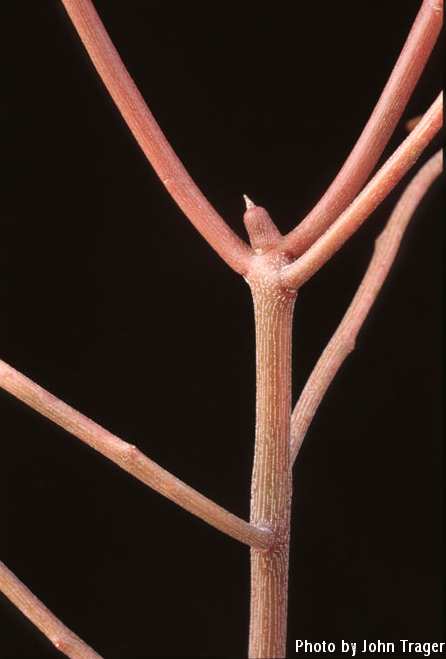The similarities to E. stenoclada have already been mentioned (see E. stenoclada). In contrast, E. tirucalli is a very widespread species resulting in the publication of several names for regional variants that have since been synonymized. Such is the case with the form offered here. It was originally described as E. laro, which is simply the Madagascan form of this species that ranges from Africa to Asia. Our seedlings are of a vivid reddish color compared to the plain green of rooted cuttings of E. tirucalli typically available in cultivation. This juvenile coloration may not persist into maturity. HBG 89140, plants from seed collected March, 2001, by Bana Rakotoarison in the Kirindy Forest, Morondava, Madagascar. $4.
People who have experienced contact with the milky sap of euphorbias report a variety of unpleasant symptoms. On the skin it can result in blisters if not quickly dealt with. Even the vapors can result in stinging eyes and mucous membranes of the nasal passage, and sap in the eyes can cause temporary (or long-lasting) blindness. What all collectors of euphorbias should know—and what most medical professionals and poison control centers do not—is that the sap is not water-soluble but is fat-soluble. We have found the most effective method for cleaning it from skin or tools is to first rub it off with a vegetable- or mineral-oil-soaked towel, then to wash away the oil with soap and water. Insufficient research has been done to find lipid solvents that do not harm the eyes. Folk medicine claims that the juice of Aeonium lindleyi is an antidote for euphorbia sap, but no one has volunteered their eyes for a controlled experiment to prove its worth. When taking cuttings it is advisable to wear protective gloves, clothing and eyewear. If working for a prolonged period when the vapors are likely to be inhaled, a respirator fitted with organic chemical filters will prevent respiratory irritation.

Published in the Cactus and Succulent Journal, Vol. 75 (2), March - April, 2003